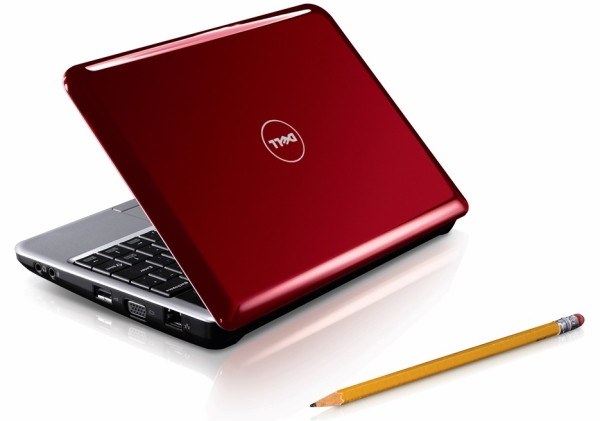Hackintosh-friendly Dell Mini 9 Discontinued
Goodbye, best hackintosh netbook yet.
Most of the new netbooks announced today are of the 10-inch variety. While the netbook concept may have started off with the smaller form factors with 7- to 9-inch screens, it seems that OEMs and/or consumers have decided that bigger is better.
As if we needed any further evidence that 9-inch netbooks were on their way out, earlier this month Dell discontinued the Mini 9, the PC maker’s first netbook. In its place, Dell introduced the Mini 10v, a lower-cost version of the Mini 10 but without high-end options such as the higher-resolution display and TV tuner. What the Mini 10v gave up in options, however, it gained in compatibility and mod-friendliness.
The Dell Mini 9 was popular amongst the Hackintosh crowd – those who load Mac OS X onto their PCs originally built for Windows or Linux – thanks its hardware compatibility with Leopard. Those who installed Mac OS X on their Mini 9s found near perfect hardware functionality with networking, audio and even webcam.
With the Mini 9 now no longer available, attention shifts to the Mini 10v, which adopts the Intel GMA 950 graphics critical for OS X compatibility (the regular Mini 10 and Mini 12 use the GMA 500, which does not work with OS X). Furthermore, the Mini 10v features a DIMM slot that will support an aftermarket memory upgrade to 2GB – something also not available on the Mini 10 or Mini 12. Getting at the DIMM slot requires disassembling most of the netbook, but it’s possible.
Early efforts at installing OS X on the Mini 10v have proved somewhat successful. Networking and video work fine, but audio and webcam are still spotty. The Mini 10v’s 1024 x 576 LCD is sometimes not enough to display a full menu (the Mini 9 was 1024 x 600), forcing users to tab through menus and hit enter blindly.
Perhaps with more time, the Dell Mini modders will be able to make the Mini 10v work with OS X as well as the netbook it replaces.
Get Tom's Hardware's best news and in-depth reviews, straight to your inbox.
-
skadeet the mini 9 is still being sold, but it's now branded as the Vostro A90. same hardware just the 'palm rest/track pad' piece is black instead of silver like the mini 9. but who knows how long that will last.Reply -
mcnuggetofdeath Oh Noes!!! Ppl might have to learn to use an infinitely more customizable, stable, and free OS.Reply
^^^ Linux Mint -
sstym So if you buy Mac OS X for $100 and a mini 10v for $300, you get a $400 macbook after some hacking and tweaking?Reply
I can already see tears of rage on the pristine white keyboard of a macbook white, hear moans of despair in an Apple boardroom and read some inane "You'll only do that because you're not cool/hip/trendy/flush with disposable cash and devoid of ideas/ to buy a real macbook". -
Ambictus mcnuggetofdeathOh Noes!!! Ppl might have to learn to use an infinitely more customizable, stable, and free OS. ^^^ Linux MintReply
Mint is a beautiful thing... I highly recommend! -
Hanin33 mcnuggetofdeathOh Noes!!! Ppl might have to learn to use an infinitely more customizable, stable, and free OS. ^^^ Linux MintReply
an infinitely more useless than osx... the state of linux apps being atrocious at best... sure it's stable because all the software for it is archaic to say the least. if you're fine with super minimalist desktops... linux is for you! -
hellwig Wait a minute, the 9" notebook was 1024x600, but the 10" notebook is 1024x576? This is why computers monitors SHOULD NOT be in a 16:9 ratio. It makes sense for TVs, cause thats the ratio used by the TV programming, but for computers, its just pointless. And no, I don't care if you only use your computer and monitor for watching DVDs, you wasted your money, get over it. I can watch movies just fine on my 16:10, I don't even notice the black bars.Reply -
mindless728 hellwigWait a minute, the 9" notebook was 1024x600, but the 10" notebook is 1024x576? This is why computers monitors SHOULD NOT be in a 16:9 ratio. It makes sense for TVs, cause thats the ratio used by the TV programming, but for computers, its just pointless. And no, I don't care if you only use your computer and monitor for watching DVDs, you wasted your money, get over it. I can watch movies just fine on my 16:10, I don't even notice the black bars.Reply
minimalist desktop, have you used KDE 4.2 -
anamaniac Pathetic replacement...Reply
Larger screen but worse resolution.
For any functional purpose, to me the resolution wins. My eyes are good enough.
I am honestly more interested in the mini 9...

